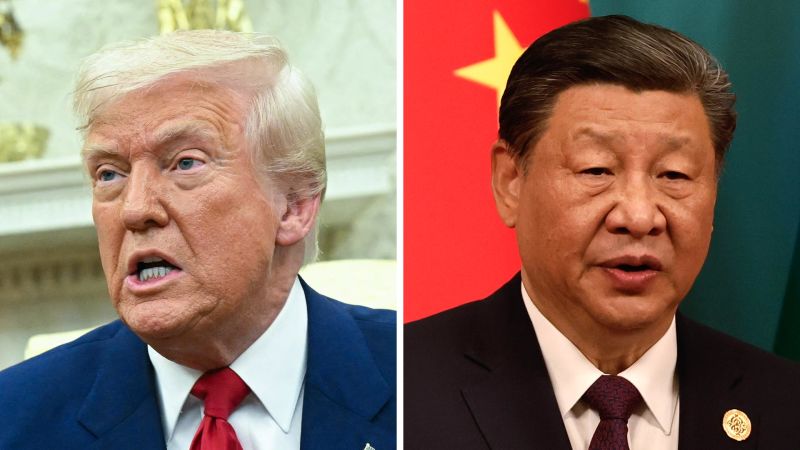On a Wednesday marked by significant economic developments, a tariff reprieve announced by President Donald Trump set off a wave of optimism across global markets. The White House revealed that it had been in contact with a multitude of countries to explore potential trade deals, scheduling various calls and meetings for the weeks ahead. However, one notable country was absent from this outreach initiative: China.
As many nations enjoyed a temporary halt on tariff escalations, Trump instead decided to intensify tariffs on Chinese imports, introducing a staggering additional charge of 145% on all Chinese goods coming into the United States. In retaliation, Beijing imposed an 84% tariff on American goods and embarked on a plan to hinder a key U.S. sector by restricting the export of American films. The stage seemed set for an unprecedented trade war between the world’s two largest economies, both countries watching intently for any sign of capitulation from the other.
Reports from two senior officials in the White House indicated a firm stance: the United States would wait for China to initiate contact. Trump had made it clear that he viewed the actions taken by Beijing as a choice to escalate tensions and retaliate. This rigid position had been communicated to Chinese authorities over the past two months, suggesting that President Xi Jinping should take the first step and request a conversation with Trump. Yet, this overture met with persistent refusal from Beijing to arrange any substantive dialogue at the leadership level.
One challenge behind this impasse was Xi’s unwillingness to appear weak by being the first to reach out, according to Trump’s team. The U.S. president harbored ambitions of constructing a significant agreement with China, aimed at boosting American exports, combatting fentanyl trafficking, and restructuring TikTok for U.S. users. Trump expressed his belief that China was eager to negotiate but was simply uncertain about how to proceed, attributing their hesitation to a sense of national pride.
Nonetheless, the leaders of both nations appeared to be speaking past one another. While lower-level official communications remained active, high-level discussions had stalled. Informal dialogues also proved fruitless, suggesting both sides were ensnared in a protracted game of economic brinkmanship, with no clear resolution in sight. Various U.S. officials noted that China’s methodical approach toward diplomatic protocol was fundamentally incompatible with Trump’s more impulsive, transactional style.
Despite attempts to establish a back channel for communication—similar to previous practices with President Joe Biden’s administration—China’s initiative hit a snag. The Trump administration expressed skepticism about engaging with China’s Foreign Minister Wang Yi, arguing that he lacked proximity to Xi’s core circle of decision-makers. Specific names of preferred U.S. interlocutors had been proposed to Chinese officials, but those suggestions were reportedly disregarded.
The lack of clear and respectful communication seemed to exacerbate tensions, particularly after a mischaracterized readout from a call between Secretary of State Marco Rubio and Wang. Singapore’s Commerce Ministry urged that any deliberations must be grounded in mutual respect, warning that should the U.S. choose a confrontational path, China would respond in kind. Against this backdrop of rising tensions, the White House sought to forge trade agreements with Japan, South Korea, and Vietnam, looking to apply pressure on Beijing.
Amidst speculation of reopening communication channels, current and former U.S. officials highlighted that establishing conditions conducive for a Trump’s call with Xi was essential. They were determined to reassure China that their leader would not encounter hostility during potential discussions, especially in light of previous encounters that had been described as confrontational. This sentiment was echoed by former officials, who suggested that clarity and mutual understanding were vital before the dialogue could resume.
Efforts were underway for Chinese officials to channel direct communications to Trump via influential business leaders. There had even been ambitions to use Tesla CEO Elon Musk as a bridge between Washington and Beijing, but despite high hopes, progress remained elusive.
As discussions on trade policy continued, Beijing appeared to contemplate indirect retaliatory measures against prominent U.S. corporations leveraging significant operations in China, yet ultimately refrained—concerned about the potential backlash from Chinese consumers.
Looking forward, it became evident that China’s strategists were considering countermeasures beyond merely raising tariffs. They might explore sourcing agricultural products from Brazil rather than the U.S. heartland, similar to tactics employed in prior trade conflicts. The Chinese leadership’s apparent ability to use non-tariff weapons hinted at a growing discomfort with escalating trade hostilities, particularly as both countries remained engaged in a test of economic resilience.
Amid all these complexities, it remained unclear just how far either country was willing to go in applying economic pressure or making concessions, raising questions of mutual economic reliance and the limits of each side’s capacity for endurance in this standoff. With broader implications for global markets, the stakes seemed higher than mere economic interests, hinting at potential geopolitical consequences that could reshape international relations across multiple spheres of influence.
In the end, while the whispers of potential negotiations floated in the air, experts remained



